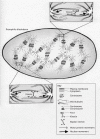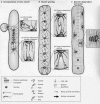Nuclear movement in multinucleated cells
- PMID: 36305464
- PMCID: PMC10655921
- DOI: 10.1242/dev.200749
Nuclear movement in multinucleated cells
Abstract
Nuclear movement is crucial for the development of many cell types and organisms. Nuclear movement is highly conserved, indicating its necessity for cellular function and development. In addition to mononucleated cells, there are several examples of cells in which multiple nuclei exist within a shared cytoplasm. These multinucleated cells and syncytia have important functions for development and homeostasis. Here, we review a subset of the developmental contexts in which the regulation of the movement and positioning of multiple nuclei are well understood, including pronuclear migration, the Drosophila syncytial blastoderm, the Caenorhabditis elegans hypodermis, skeletal muscle and filamentous fungi. We apply the principles learned from these models to other systems.
Keywords: Cytoskeleton; LINC complex; Nuclear movement; Syncytia.
© 2022. Published by The Company of Biologists Ltd.
Conflict of interest statement
Competing interests The authors declare no competing or financial interests.
Figures





Similar articles
-
Conserved SUN-KASH Interfaces Mediate LINC Complex-Dependent Nuclear Movement and Positioning.Curr Biol. 2018 Oct 8;28(19):3086-3097.e4. doi: 10.1016/j.cub.2018.08.001. Epub 2018 Sep 20. Curr Biol. 2018. PMID: 30245107 Free PMC article.
-
Genetic Analysis of Nuclear Migration and Anchorage to Study LINC Complexes During Development of Caenorhabditis elegans.Methods Mol Biol. 2018;1840:163-180. doi: 10.1007/978-1-4939-8691-0_13. Methods Mol Biol. 2018. PMID: 30141045 Free PMC article.
-
Moving and positioning the nucleus in skeletal muscle - one step at a time.Nucleus. 2015;6(5):373-81. doi: 10.1080/19491034.2015.1090073. Nucleus. 2015. PMID: 26338260 Free PMC article. Review.
-
The Caenorhabditis elegans SUN protein UNC-84 interacts with lamin to transfer forces from the cytoplasm to the nucleoskeleton during nuclear migration.Mol Biol Cell. 2014 Sep 15;25(18):2853-65. doi: 10.1091/mbc.E14-05-0971. Epub 2014 Jul 23. Mol Biol Cell. 2014. PMID: 25057012 Free PMC article.
-
Nuclear migration events throughout development.J Cell Sci. 2016 May 15;129(10):1951-61. doi: 10.1242/jcs.179788. J Cell Sci. 2016. PMID: 27182060 Free PMC article. Review.
Cited by
-
Aligning with the 3Rs: alternative models for research into muscle development and inherited myopathies.BMC Vet Res. 2024 Oct 18;20(1):477. doi: 10.1186/s12917-024-04309-z. BMC Vet Res. 2024. PMID: 39425123 Free PMC article. Review.
-
The Drosophila nucleoporin ELYS is required for parental chromosome arrangement at fertilization.G3 (Bethesda). 2025 Jul 9;15(7):jkaf104. doi: 10.1093/g3journal/jkaf104. G3 (Bethesda). 2025. PMID: 40359232 Free PMC article.
-
Collective effects of cell cleavage dynamics.Front Cell Dev Biol. 2024 Mar 15;12:1358971. doi: 10.3389/fcell.2024.1358971. eCollection 2024. Front Cell Dev Biol. 2024. PMID: 38559810 Free PMC article. Review.
-
Skeletal muscle: molecular structure, myogenesis, biological functions, and diseases.MedComm (2020). 2024 Jul 10;5(7):e649. doi: 10.1002/mco2.649. eCollection 2024 Jul. MedComm (2020). 2024. PMID: 38988494 Free PMC article. Review.
-
Germline and Somatic Cell Syncytia in Insects.Results Probl Cell Differ. 2024;71:47-63. doi: 10.1007/978-3-031-37936-9_3. Results Probl Cell Differ. 2024. PMID: 37996672 Review.
References
-
- Auld, A. L., Collins, M. A., Mandigo, T. R. and Folker, E. S. (2018a). High-resolution imaging methods to analyze LINC complex function during Drosophila muscle development. In The LINC Complex: Methods and Protocols (ed. Gundersen G. G. and Worman H. J.), pp. 181-203. New York, NY: Springer New York. - PubMed
Publication types
MeSH terms
Grants and funding
LinkOut - more resources
Full Text Sources
Molecular Biology Databases

